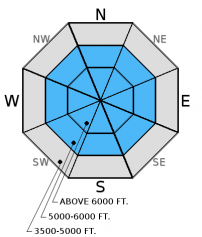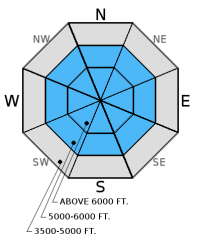| Friday | Friday Night | Saturday | |
|---|---|---|---|
| Cloud Cover: | Warm temps with rain later in the day. | Rain and Snow (above 5500-6000 feet). | Cold front passes with continued light rain and snow. |
| Temperatures: | 35 to 44 deg. F. | 22 to 28 deg. F. | 31 to 41 deg. F. |
| Wind Direction: | Southwest | Southwest | Southwest |
| Wind Speed: | 7-20 mph with gusts to 35 mph. | 12-18 mph with gusts to 40 mph. | 5-10 mph with gusts to 25 mph. |
| Snowfall: | 0-2 in. | 0-2 in. | 1-2 in. |
| Snow Line: |
Whitefish Range
Swan Range
Flathead Range and Glacier National Park
How to read the forecast
The avalanche danger is CONSIDERABLE. Warming and rain later today will cause the danger to rise at low and mid-elevations and remain elevated at upper elevations. Pay attention to changing conditions and realize the danger could rise if it rains higher and more than expected. Recent new snow over a variety of buried crusts and weak layers combined with strong wind, snow, and rain is a recipe for avalanches. Careful snowpack evaluation, cautious route-finding, and conservative decision making are essential.

3. Considerable
?
Above 6500 ft.
3. Considerable
?
5000-6500 ft.
3. Considerable
?
3500-5000 ft.
- 1. Low
- 2. Moderate
- 3. Considerable
- 4. High
- 5. Extreme
-
Type ?
-
Aspect/Elevation ?

-
Likelihood ?CertainVery LikelyLikelyPossible
 Unlikely
Unlikely -
Size ?HistoricVery LargeLargeSmall

Wind Slab: All ranges received a lot of snow over the past week with the Swan Range receiving the lion's share of the precipitation (over 4 feet since last Wednesday). Moderate to strong southwest winds over the past 72 hours continued to load leeward and cross-loaded slopes. Human triggered wind slabs up to 16 inches were reported and observed Wednesday in the Whitefish and Swan Ranges. These slabs broke within the storm snow, but thicker wind slabs on deeper layers are possible. Winds are forecasted to be strong with extreme gusts (into the 60 mph range near the Continental Divide) later today and tonight. With these wind speeds, I expect both natural and human triggered wind slabs at upper elevations by tomorrow morning.
Storm Slab: Up to 2 feet of new snow now rests on the January 17 crust, and lingering storm slabs exist on all aspects. On Tuesday, weaker snow surrounding this crust fractured and propagated in our stability tests. We observed shooting cracks Wednesday on non-wind loaded slopes as well. Storm slab avalanches could fail within the new storm snow or at deeper interfaces. With warming and potential for rain today, storm and wind slabs will become more cohesive which could make them more sensitive to triggering.
-
Type ?
-
Aspect/Elevation ?

-
Likelihood ?CertainVery LikelyLikelyPossible
 Unlikely
Unlikely -
Size ?HistoricVery LargeLargeSmall

Temperatures at upper elevations are already near or above the freezing mark. Human triggered and natural wet, loose avalanches are likely to occur as the day progresses. Given the already warm temperatures, I suspect it will be easy to trigger wet sluffs this afternoon with some added precipitation. Signs of wet snow instability include moist surface snow and roller balls forming on steep slopes and cutbanks. Loose, wet avalanches can become large and knock you off your feet, or sled, and even entrain enough snow to bury you. Use extra caution when traveling near terrain traps like narrow gullies, steep treed areas, and cliffs.
-
Type ?
-
Aspect/Elevation ?

-
Likelihood ?CertainVery LikelyLikelyPossible
 Unlikely
Unlikely -
Size ?HistoricVery LargeLargeSmall

There is a lot of variability across the advisory area with this problem that warrants careful snowpack evaluation and cautious route-finding. Buried surface hoar and weak faceted snow exist in all ranges, but you won't find them on all slopes. These weak layers are now 2.5 to 4.5 feet deep after the recent storm, and are still fracturing and propagating in stability tests (see observations). Given the tricky distribution of these persistent slabs it would be wise to avoid steep, open slopes and convexities. Look for obvious signs of instability like recent avalanche activity, shooting cracks, and whumpfing. The only way to know if these layers are reactive is to dig into the snow and perform stability tests. Today's added precipitation could be enough to tip the scales on these persistent slabs.
Two separate skiing parties near Essex in the Flathead Range yesterday reported reactive layers 2-3 feet from the surface in their stability tests . Their tests showed these layers fracturing and propagating (observations) in Extended Column Tests. Yesterday, in the southern Whitefish Range we noted active wind loading from moderate southerly wind.
On Hash Mountain in the Lost Johnny drainage in the Swan Range on Wednesday, we were able to easily trigger three wind slabs on northerly aspects from the safety of the ridge above. All slabs were about 12-14 inches deep and propagated wide across each slope (video and observation). In our stability tests, the layer of facets and surface hoar below the 1/12 rain crust fractured and propagated as well (observation). We also observed a small natural avalanche at about 5200 feet that likely occurred within the past 24 hours (photo).
Also on Wednesday, a couple of skiing parties just outside the boundary of Whitefish Mountain Resort reported triggering a wind slab on a north aspect up to 16 inches deep (observation), and no one was caught.
On Tuesday, Mark and I observed active wind loading throughout the day onto north and east aspects on Tunnel Ridge in the Flathead Range. On a north aspect we found a new, very thin rain crust that formed on January 17 and, at that time, was buried beneath 6 inches of surface snow. Stability tests resulted in fracture propagation with easy force below this crust and fracture propagation with hard force below the January 12 rain crust (observation, video, photo).
Also on Tuesday, BNSF avalanche safety noted active windloading on east and northeast aspects and windslab conditions on northeast - south aspects. They also observed shooting cracks and were able to intentionally trigger small soft slabs on leeward slopes (observation).
Visit our Observations page and our You Tube channel for more observations from the entire season.
Thanks to everyone for submitting observations. They are extremely useful and could help save lives.
HOW TO SUBMIT OBSERVATIONS:
Email: [email protected]
Call and leave a message: 406.387.3821
You can also submit quick observations via text: 406.241.4571 (FAC mobile)
OR
Submit Snowpack Observations: http://www.flatheadavalanche.org/node/add/snowobs
Submit Avalanche Observations: http://www.flatheadavalanche.org/node/add/avyobs
Within the past 24 hours, 1-3 inches accumulated throughout the advisory area. Winds were moderate to strong out of the southwest. Currently, mountain temperatures above 6000 feet range from 29º-35º F and winds are 8-10 mph out of the southwest with gusts to 23 mph. The big story today into tonight is warming temps, rain, and strong to extreme winds. For today, expect temperatures to rise into the mid-30s to low 40s F. Wind speed will increase out of the south-southwest at 10-20 mph with gusts to 50 mph (in locations close to the Continental Divide). Wind will continue to increase tonight with average speeds of 15-30 mph and gusts to 65 mph. Rain at lower elevations by late morning/early afternoon will creep upwards to around 5000-6000 feet by tonight. The precipitation appears to favor the northern part of our advisory area. Pay attention to changing weather conditions with warming and potential rain on snow and how this may affect stability.
| 0600 temperature: | 29 to 35 deg. F. |
| Max. temperature in the last 24 hours: | 30 to 35 deg. F. |
| Average wind direction during the last 24 hours: | South-Southwest |
| Average wind speed during the last 24 hours: | 2-11 mph |
| Maximum wind gust in the last 24 hours: | 17-25 mph |
| New snowfall in the last 24 hours: | 1-3 inches |
| Total snow depth: | 57-84 inches |
This advisory applies only to backcountry areas outside established ski area boundaries. This advisory describes general avalanche conditions and local variations always occur. This advisory expires at midnight on the posted day unless otherwise noted. The information in this advisory is provided by the USDA Forest Service who is solely responsible for its content.








































